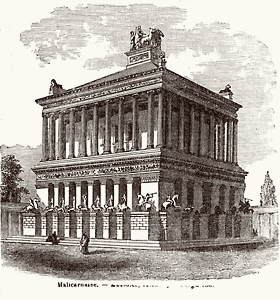Halicarnassus

HALICARNASSUS (originally called Zephyria), Ancient city in Caria (Asia Minor), on the Ceramic gulf. Today its site is occupied by the town of Boodroom or Budrun, 75 miles (120 km) S. of Smyrna (pop. approximately 10,000), remarkable only for the ruins of the old city. Halicarnassus was founded by a Trœzan colony and it was one of the six cities which constituted the doric exapole. It was conquered by the Persians under Darius. They let the Greek Lygdamis rule it, with the title of dynast. Artemisia, daughter and successor of Lygdamis, fought with the fleet of Xerxes at Salamis. around 380 BC, the city appears to have belonged to half-independent carian princes, among which the most famous was Mausolus, who rebuilt it and fortified it. He died in 352 and for his tomb, his young wife Artemisia had a monument erected which was so magnificent, that such constructions are still called mausoleums. A little time later, the city returned to Persia. Alexander the Great burned it, a catastrophy from which it never completely recovered. The historians Herodote and Denys were born in Halicarnassus. In the XVI th century, the city was taken by the Turks from the knights of Saint-John, who had built a castle called the Tower of Saint-Peter, around 1402. The mausoleum was considered one of the seven wonders of the world. It was still there in the XII th century; but it was thrown down either by an earthquake or by lightning before the knights built the castle. The ruins, carried down along the slope of the hill, filled the lower part of the city and covered it completely, reaching a depth of 7.7 yards (7 m) in some places. In 1856-57, the site of the mausoleum was discovered by Newton, who was the English vice-consul in Mytilene; excavations were made and a great number of statues and sculptures were found, which were left with the British museum. Among the statues, that of Mausolus, which was reconstituted from 63 pieces, stands out. Using the partial measurements provided by Pliny, Mr. Newton and then Mr. Fergusson tried to restore the layout of the mausoleum. It resulted in two very different plans. (Our engraving gives that of Fergusson.).
Extract from the Trousset encyclopedia, 1886 – 1891.
Tags: antiquity, archeology, Asia, buildings and monuments, history, tombs, Trousset encyclopedia


